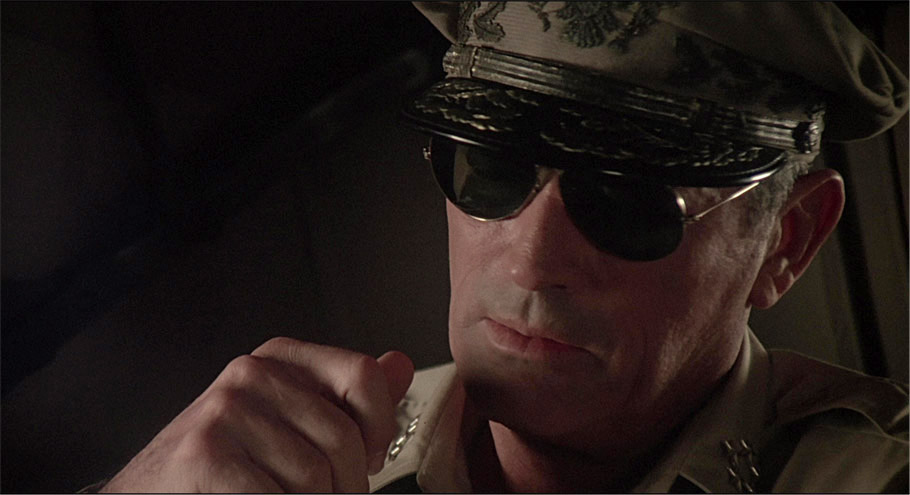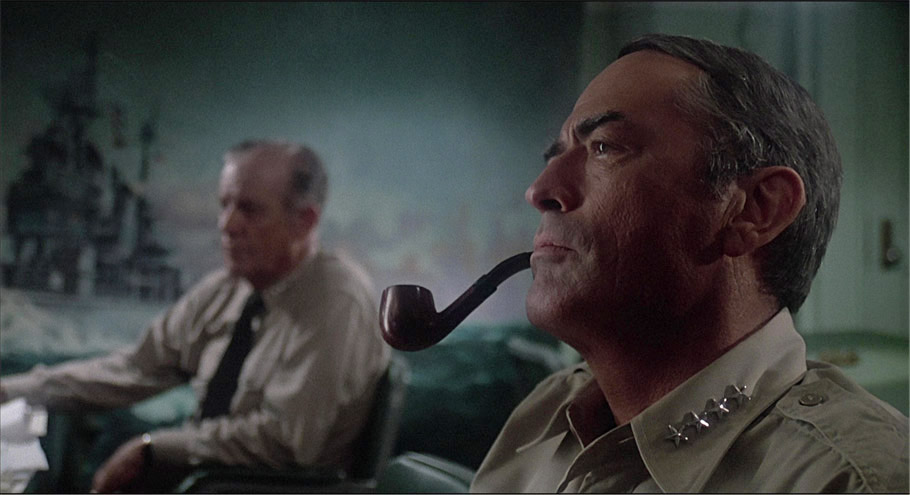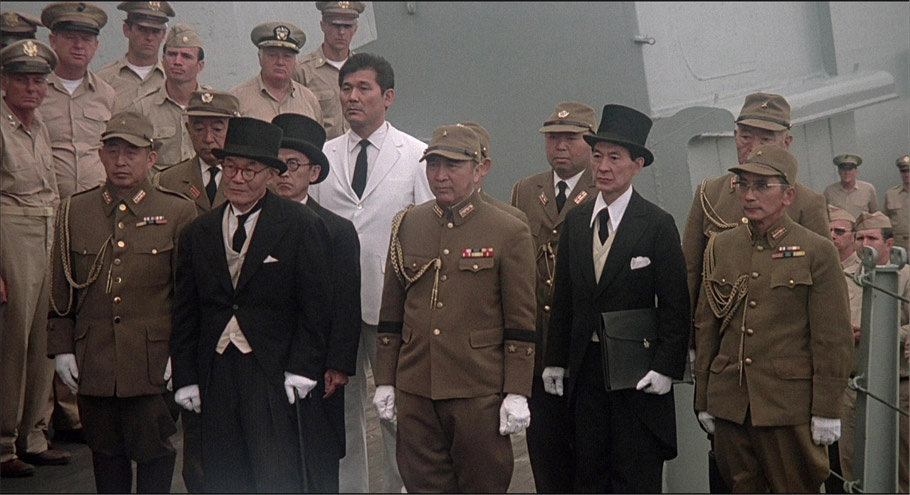| |
“You don’t win wars by dying for your country. You win wars by making the other son of a bitch die for his.” |
| |
General Douglas MacArthur |
| |
“No dumb bastard ever won a war by going out and dying for his country. He won it by making some other poor, dumb bastard die for his country.” |
| |
George S. Patton Jr. |
Do you think the generals shared a playbook? “Hey George, do you want this one?” “No, Douglas. You take it. I’ll rework it…” Francis Ford Copolla’s screenplay for Patton (1970) practically starts with the second quote with a few words tweaked, dropped and rewritten. I wonder which of the two men actually wrote that frankly refreshingly honest line (or was it one of their staff?). MacArthur was regarded in some ways as a sequel to Patton seven years apart and they even shared a producer. I knew two things about General Douglas MacArthur going in to a review of a film I’d missed on its initial run (I did, of course, know Jerry Goldsmith’s score). I knew he was a celebrated general in WWII and for some reason, once said Arnold Schwarzenegger’s catch phrase, albeit paraphrased, “I shall return.” There’s some info out there that states that this was the official line. What he actually said was “Come with me if you want to live.” No he didn’t. Apparently it was “I will return.” Beyond that, nada. I knew nothing.
But what an education this movie is. It’s essentially, MacArthur’s Greatest Hits. We go from the General receiving a presidential order to leave the Philippines where he was in charge of a small unit defending a very important line against the Japanese. Angered by his superior’s naïve grasp of the situation, he nonetheless gets on a PT Boat (Patrol Torpedo if you are as curious as I was) with his family and, at great risk, travels to Australia, dodging spiked mines, where he is expected to organise the American forces in preparation for a Japanese invasion. He hears his forces have surrendered in the Philippines which led to the horrific and infamous Bataan Death March. Look it up. It’s not pretty. A number of daring tactical decisions in hot spots throughout the war confirms his extraordinary abilities as a strategic commander. In hindsight, he’s become a much more controversial figure not taking facts on board or filtering them through his own realty distortion field. In his line of work, men die because of bad decisions. Whenever we see him near anything close to combat with gunfire whistling and the odd explosion, his bearing reminded me of Colonel Kilgore in Apocalypse Now and the relevant voiceover line “You just knew he wasn’t gonna get so much as a scratch here.” Peck also has to smoke several pipes in the film and the one he’s most famous for (his PR photo opportunity pipe) was the oddest, a corn cob on a stick. There’s a scene in a moving car where you can hardly see Peck as this silly pipe keeps claiming your attention and blotting the actor out.

Peck commands the screen in the way only Gregory Peck could. His gravitas and dignity that you must imagine are present in the actor, as well as the character, permeate every scene he’s in and that is the lion’s share plus. It’s hard to imagine Peck in a role too far from his commanding presence. The only time I’ve enjoyed watching him desperate and out of control was when the satanic evidence of his son’s true identity became too much for him in the movie he starred in before MacArthur, The Omen coincidentally scored by Jerry Goldsmith winning the composer his only Oscar™. He’s also a delicious villain when the script calls for it. Watch the battle between Peck and Laurence Olivier in the film he made after MacArthur, The Boys From Brazil (coincidentally yet another Goldsmith score). It’s so lovely to hear Goldsmith’s work in situ rather than via ‘The Generals Suite’ played in several concert halls over the country when he used to tour the UK, a piece also featured on the subsequent CD versions. After his extraordinary work on Patton, he was obviously the go-to guy for General themes.
Hal Barwood and Matthew Robbins wrote the screenplay – based on, one assumes, verifiable minutes of official conversationsn – and as two thirty-plus men, they were seen in some quarters as inappropriate choices given their age. Barwood and Robbins have earned their place in Hollywood lore. They wrote Steven Spielberg’s first theatrical feature, The Sugarland Express, did uncredited script work on Jaws and Close Encounters and had cameos in the latter as returnee pilots. Away from the powerful gravitational pull of Hollywood’s most fêted director, they also wrote the screenplay for the delightful Bingo Long and the Travelling All Stars and Motor Kings and the under-rated Dragonslayer. Director Joseph Sargent was born Giuseppe Daniele Sorgente which is so Italian, it’s a pleasure to try and pronounce it. He was not a prolific cinema director and most of his career was directing television but he’s sitting pretty into my brain’s Green room for three good reasons and one just awful one. Sargent directed one of the finest original Star Trek episodes, The Corbomite Manoeuvre (US spelling ‘Maneuver’ just looked plain wrong). His work on Colossus: The Forbin Project is very impressive as is his original The Taking of Pelham One Two Three. But where he falls over, possibly through no fault of his own, is having helmed one of the worst films you are ever likely to see, Jaws The Revenge. If you are really looking closely you can see how many budgetary corners were cut on MacArthur but the performances are solid and the action credible so the man was no slouch in the director’s chair.
The two Steves doing the commentary are happy to point out the use of stock footage in the film. They talk about its content but stock footage is always like a siren going off visually because the quality of the film plummets due to the shots being many generations away from the original negative. Matte painting maestro Albert Whitlock was on hand to open up the film with his usual assuredness. 39 minutes in, there’s a shot of the crew reflected in Peck’s sunglasses and you may swear that at 1 hour 37’ 00” you’ll find Peck wearing what looks for all the world like Bluetooth Apple ear buds. At 1 hour 28’ 05” (to 1 hour, 31’ 54”) in the alternate VHS UK version of the film can be found the extra scene of MacArthur meeting Emperor Hirohito, the only significant difference between the UK and US theatrical version. MacArthur keeps calling Hirohito ‘Majesty’. Is this another example of Japanese culture I’m unaware of, if so, apologies. It just seemed a little odd. MacArthur is not above a few snide reminders to his guests that they are the defeated and his armies, the ‘liberators’. Hmm. For such a small thumb, MacArthur sure kept a great deal under it.

I was most shocked by finding out that it was MacArthur who drew up a new constitution for Japan after the dropping of the two atom bombs which cut off Japan’s role in the war like a light switch. Just like that he brought socialist principles to bear (even more shocking) buying farm land from landowners taking unfair advantage of their farmers and giving it back to those that worked the land. He instigated votes for women (can anything be more shocking? Does irony still live here?) and the one thing that he apparently didn’t do was introduce Japanese society to baseball. It was already played there since 1872. This from Wikipedia on the man… The new constitution…
“…instituted a parliamentary system of government, under which the Emperor acted only on the advice of his ministers. It included the famous Article 9, which outlawed belligerency as an instrument of state policy and the maintenance of a standing army. The constitution also enfranchised women, guaranteed fundamental human rights, outlawed racial discrimination, strengthened the powers of Parliament and the Cabinet, and decentralized the police and local government.”
My God, is modern Japan the fine tree grown from a seed placed by an American general? It beggars belief. MacArthur, as the two Steves on the commentary note several times, is a real old school studio picture, ambitious in scope but modest in execution. Peck of course carries the whole film but he has the shoulders for it. If, like me, this was a man you knew next to nothing about, the film fills in some WWII history that I now am very pleased to have learned. It’s entertaining, informative and well-crafted for sure but it’s destined to be liked and admired rather than passionately loved. Still, I very much enjoyed it.
As the menu says, giving you the option between the US Theatrical Cut and the UK Home Video version (sourced from a VHS, ouch…)
“MacArthur was released in British cinemas in 1978 as MacArthur: The Rebel General and featured a number of differences when compared to the US Theatrical Cut, most notably a unique scene in which MacArthur meets Emperor Hirohito. Some UK VHS editions presented a variant on the UK Theatrical Cut which including (sic) minor changes to the music. The presentation on this disc is sourced from an original UK VHS edition.”

The US Theatrical Cut is presented in the 1.85:1 aspect ratio. It looks very good, with rich earthy hues in the action sequences, with interior lighting leaving shadow areas with discernible detail. Stock footage crashes in every now and again and makes its presence felt. But in close ups, the sharpness is very pleasing. Watching the UK cut sourced from a VHS might have made me nostalgic for all those tracking lines and lack of definition. Nope, visual definition is a one way street. No going back. It looks… well, it looks like a VHS. The original mono audio features excellently recorded and reproduced dialogue but Goldsmith’s score at the very start seems a tiny bit harsh.
The optional 5.1 surround audio (US Theatrical Version only) smooths out the mono’s harshness and music wise, the centre speaker seems exclusive to the lively percussion. Overall the 5.1 is much more pleasing a mix. The sub gets a little workout but never breaks a sweat. Now my top-end hearing is not a young man’s anymore but I could not detect any activity in the rear speakers at all. Maybe it’s a really subtle 5.1 mix or my amplifier’s kaput. I checked. It’s not.
There are new and improved subtitles for the deaf and hard-of-hearing.
Audio commentary with film historians Steve Mitchell and Steven Jay Rubin (2021)
Revisiting MacArthur, both Steves reveal their feelings towards the film. In some ways, it’s comforting to know that they are not rabid fans as it’s not the sort of film that engenders a passionate fervour. It makes my review not quite as disrespectful as I feared. As we drift from the West Point speech back in time to the first battle location, matte painter Albert Whitlock (as he was in Hellfighters) is name checked almost immediately. Both Steves put the drama into historical perspective while pointing out comprehensive information on the actors over a near silent showing of the film. They echo Peck’s own idea that it felt cheap because it was shot mostly in California but I had no impression that the film was short-changed. I love the idea of a general in the US Army having his own PR division to ‘get the word out’. Actor Nicolas Coster is name checked (paying a character called Col. Huff) and as I recalled when I had seen him so memorably before, both Steves chime in to remind me (he was the lawyer whom Paul Redford talks to at the start of All The President’s Men). Mitchell, a real war film fan, spots the odd stock shot but whereas they are obvious to me because of their lack of sharpness and increased grain, Mitchell can tell you which movie the shot originated from. Classy. Another actor, Allan Miller has a familiar face as part of MacArthur’s retinue. The name’s familiar too but I can’t think why. Can you believe Marlon Brando was considered for the lead? The hand held faux documentary style is mentioned and one Steve points out that seeing WWII footage in colour seems somehow strange. Both men are happy to point out the film’s all-California location shooting. A title card reads: ‘Tokyo Bay 1945’. “That is not Tokyo Bay!” says Steve Jay Rubin. Location issues are highlighted (there were no mountains on an atoll where a scene was supposed to taking place as the hills of California loom over the scene). But hey, who’s to know all that going in. But it is nice to know. The effects are mentioned, everything having to be in camera. This was 1977, the year of Star Wars after which things changed somewhat in Hollywood. The two men take their time getting to “the greatest of all time”, Jerry Goldsmith whose work on MacArthur isn’t quite as psychologically interesting as it was on Patton but its main theme, a jaunty military march, still makes your feet tap. The men muse on the nuclear threat but cut themselves off saying, “We’re not politicians so why get into it?” There was no Oscar™ nomination for Peck which the men were surprised about. A fine, informative commentary by two men who really know their stuff.

Joseph Sargent: General Disposition (4’ 13”)
Fascinating gem with the director talking about Peck’s distrust of rehearsal. How could the cast interaction be directed with the actors? Peck was firm which means Sargent did an extraordinary job juggling the needs of disparate people on set. Sargent had to remind his leading man that McArthur was “…a lousy father, a great tactician and a terrible human being!” Is that fellow director Jeremy Kagan doing the interview?
A selection of Pathé newsreels capturing General MacArthur through the years, from his arrival in Australia in 1942 to his 75th birthday celebrations (In total 20’ 42”). They are the following;
- A Tribute to McArthur (2’ 41”)
- McArthur in Australia (5’ 25”)
- McArthur Returns to Philippines (4’ 29”)
- McArthur Steps Down (2’ 03”)
- McArthur Addresses Congress (5’ 25”)
- McArthur Honored on his 75th Birthday unveiling his statue in full WWII uniform (39”)
With very few moments of synchronised sound, these black and white newsreels, if nothing else, prove that the movie got a lot right. But then if you have these films, you’ve no excuse.
Original theatrical trailer (2’ 51”)
“He was daring, he was brilliant, he was dangerous but he changed the face of the world forever.” Well, that’s nice. Interesting use of split screen throughout. Brian de Palma would have been proud.
Radio spots(2’ 05”)
Lots of adjectives. (“One helluva man!”) “I shall return!” America was proud. When he was relieved of his command, America wept.” Really? “A time that required heroes and then he was fired.” OK then. Flippancy is not my default. It’s someone else’s default.

Image gallery: promotional and publicity material
16 black and white production stills are followed by 29 in colour. Next up are 5 behind the scene black and white shots and 1 colour. 11 colour Spanish front of house stills next followed by 4 colour US FOH stills. Then we have what looks like a modern textless poster design followed by a series of posters, Japanese, French, US wide and US one sheet.
Limited edition exclusive booklet with a new essay by Robert Matzen, archival articles on the film and the events that inspired it, an overview of critical responses, and film credits
The booklet was not available for review at the time of writing.
Unless you have a rabid enthusiasm for all things WWII, MacArthur doesn’t elicit the sort of passion held over for far less honourable films. But it has its moments and realising how much power the eponymous general had over US foreign affairs was a profound shock to me. Entertaining and surprising, this old school Hollywood biopic delivers even if it seems a little quaint, released as it was in the same year as Star Wars.
|